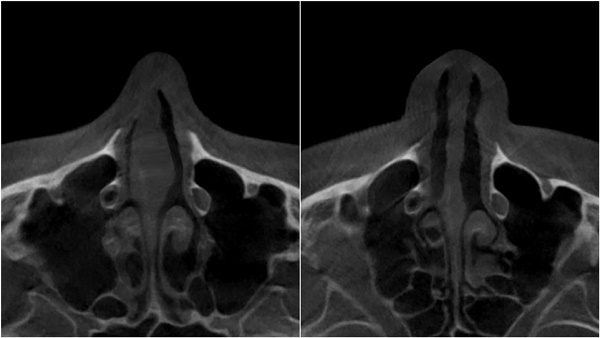Not treating the disease may lead to headaches, snoring, olfactory dysfunction
Similar ways of diagnosis and prescription… visit ENT for the deformation of the internal nasal structure
Nasal valve restructure approved as latest medical technique… insurance coverage

Nasal congestion due to a runny nose and sneezing in cold weather and in-between seasons is a common cold symptom. At this time, most people go to the internal medicine clinic for colds and receive prescriptions, but even after a few days, their nasal congestion symptoms are not cured. The symptoms of nasal congestion are that you can see a big failure if you just wait for the word, "If you take medicine, you'll get better in a week, if you don't take medicine, you'll get better in seven days." It is because of the internal structure that the nose function is broken and needs to be improved by surgery!
GNG Hospital's ENT doctors Lee Sung-hoon and Hong Sung-moon explained about septum deviation and nasal valve stenosis surgery to solve nasal congestion symptoms, the diagnosis and treatment of the two diseases in detail.
Reporter : What is the cause of nasal congestion?
Lee : Nasal congestion is a common symptom in almost all nose diseases that cause a disability in the airflow of the nose. If the nasal mucous membrane is irritated and inflamed or swollen due to allergies or infections, nasal congestion occurs. If you have a stuffy nose for a long time, breathing through your mouth can continue, leading to headaches, snoring, olfactory disorders, and decreased breathing and olfactory function.
Reporter : What diseases or lifestyle environments cause nasal congestion?
Hong : In the case of allergic rhinitis, there are many different causes, but a representative cause related to the indoor environment is house dust mite allergies. Surprisingly, rhinitis caused by pollen, yellow dust, and fine dust is well prevented outdoors due to the wearing of masks to prevent COVID-19 infection. Also, wearing a mask is very helpful for preventing acute rhinitis called sinus cold.
Reporter : Generally, when people suffer from nasal congestion, they think it’s simply cold. How can you tell where to visit between internal medicine and ENT clinic depending on the symptoms and causes?
Similar diagnoses and treatments are applied to both internal medicine and ENT for rhinitis and nasal congestion caused by acute infections, commonly called sinus colds. However, in the case of chronic nasal congestion, surgery can be considered depending on the situation like the deformed internal structure of the nose causing diseases. Recently, otolaryngology, which can operate surgery, has a nose 3D-CT scanner, so you can accurately determine whether there is deformation inside the nose.

Reporter : How do you diagnose the accurate cause of nasal congestion?
Basically, first, we check the medical history and examine structural problems of the nose based on non-endoscopic and 3D-CT results. Also, in the case of allergic rhinitis, an allergy test is conducted to accurately determine the cause of the allergy.
Reporter: How are septum deviation and nasal valve stenosis different?
Hong : The nasal septal cartilage is cartilage that rises vertically in the center of the nose and separates both nostrils, and if the bone is bent in the shape of c or s, it is called septal deviation. The nasal valve is a space corresponding to the roof of the upper septum nose, and when the nasal valve space is stenosed, you feel severe nasal congestion. Also, septal deviation and nasal valve stenosis may occur at the same time, and there may be separate problems, so an examination is required for accurate diagnosis.
Reporter : Please explain in detail the surgical methods for septal deviation and nasal valve stenosis.
Lee : In the case of septal deviation, excessively grown cartilage bones are resected and the bones bent into an empty space are straightened. Depending on the internal state of the nose, the leftover bones from resection can be used as a transplant material for nasal valve reconstruction by making a support. Nasal valves are classified into internal valves and external valves. Internal valve surgery is a method of expanding the space by implanting septal cartilage pieces into the constrained space, and the external valve is applied with surgery to strengthen them through cartilage or skin transplantation because the wing cartilage is weak.
Reporter : What are the side effects of septal deviation and nasal valve stenosis?
Lee : Our bodies tend to return to their original state after surgery, which can lead to a recurrence in which the partial septal cartilage bends again during the recovery process. To prevent these side effects, minimized resection of cartilage and technical skills are needed to properly strengthen support when necessary.
Nasal valve reconstruction requires the use of other alternative materials in case of insufficient septal cartilage or weak cartilage to be collected. There are donated cartilage or PCL plates, which are new materials, and if there are not enough self-materials, it is also important to see a professional doctor who has a lot of experience in surgery.
Reporter : Do insurance cover surgeries for nasal valve stenosis and septal deviation?
Hong : In the past, only septal deviation had a disease code, so health insurance or actual cost insurance benefits could be given, but since 2016, nasal valve reconstruction, which improves nasal valve stenosis, has been recognized as new medical technology and be covered by insurance.
Reporter : What lifestyle habits would help prevent nasal congestion?
In the case of acute rhinitis and allergic rhinitis caused by infection, make sure to wear a mask when you go out to prevent germs, viruses, and allergy-causing substances. Also, if you improve the habit of washing your hands frequently and not touching your face with your hands, it helps prevent nasal congestion. It is also helpful to clean your nose regularly to prevent dryness.


